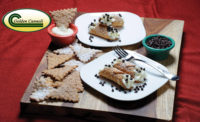Improving pizza performance






Even though frozen pizza is a relatively flat market these days, seeing only 1.04 percent growth in dollar sales for the 52 weeks ending Nov. 30, 2014, per IRI, Chicago, it’s still a $4.4 billion market—and select brands have shown an ability to outpace the category average.
Brand strength
Back in 2013, Bernatello’s Pizza, Maple Lake, MN, dropped its company name from its lines—historically well known in the Minneapolis area—in favor of new names, like Brew Pub. This clearly indulgent line favors use of a moderately sized Brew Pub logo and a large-sized “Lotzza Motzza” tag line front-and-center, building on the appeal of indulgence.
The company also secured the Orv’s brand in a 2012 acquisition and continued it, discontinuing the Bernatello’s product that previously competed with it. The strategy is working, and the company saw 22.85 percent dollar sales growth for the 52 weeks ending Nov. 30, 2014.
Strong performers for category leader Nestlé, Solon, OH, include Jack’s and DiGiorno’s Pizzeria! line. The latter, launched in 2013, achieved $89 million in its first year of release, according to Amy Kraushaar, category manager, food and drinks, Mintel, Chicago. Dollar sales for the period ending Nov. 30, 2014, per IRI, were up 30.83 percent.
These brands often resonate with shoppers due to pizzeria-style attributes built into the formulation—premium ingredients, often an irregular crust pattern and superior crust characteristics.
“Wood-fired” is a descriptor that’s increasingly coming into play with crusts. Midwest regional brand Connie’s—a retail CPG extension of the pizzeria chain of the same name that works with Nation Pizza and Foods, Schaumburg, IL, for its frozen retail line—recently released a Wood Fired line, with descriptors like “all natural,” “minimally processed,” “no artificial ingredients” and “restaurant quality” on packaging.
The Red Baron brand, from Schwan’s Consumer Brands, Marshall, MN, also works “fire” into one of its lines, Red Baron Fire Baked, which has been on the market for several years.
American Flatbread, Waitsfield, VT, also plays with fire, billing its line of flatbread pizzas as “baked in a wood-fired oven.” Varieties include Ionian Awakening (mozzarella, Asiago and feta with red onion and kalamata olives) and Revolution (mushrooms and caramelized onions with mozzarella, Asiago and grana padano cheeses).
Italian-style pizza crusts benefit from use of Italian-style “00” flour due to its high protein content, notes Don Trouba, marketing director, Ardent Mills, Denver, “which creates a soft, supple dough that works well in both hand-stretched and sheeted doughs. It also offers great mixing tolerance, excellent water absorption and works well with long fermentation.” He says it can also be a great choice when working with wood-fired pizza ovens.
Another Schwan brand, Freschetta, has seen success of late, up 24.96 percent in dollar sales for the period. The brand received a boost from its gluten-free pizzas, launched in 2014 and available in pepperoni or cheese. Key ingredients in the crust are tapioca starch, rice flour and rice starch.
A key factor in retaining retail pizza consumers remains quality. “Not only is taste and texture profile of a pizza important, but final packaging appearance is a major concern for most pizza manufacturers,” says Ed Cordiano, program manager, Bakery & Prepared Food, Linde North America, Murray Hill, NJ. “Cryogenic technology allows companies to quickly freeze pizza prior to packaging. Additionally, the quick freeze preserves the quality of the dough, sauce, cheese and other product toppings.”
All about the crust
Compared to ready-to-bake frozen pizzas, pizza and flatbread crusts have seen slightly stronger performance for the period, with the category up 3.18 percent in dollar sales.
“One of the biggest factors having an impact on pizza trends today is that of choice,” says Trouba. “Whether it’s in the grocery store or a pizzeria, consumers are bombarded with more options to pick from than ever before. Although this has mostly been driven by toppings, pizza styles and methods—think New York, Napolitano or brick oven—the interest in novel crusts has been rising for some time.”
The ingredients in the mix have significant impact on crust quality. “Ingredient selection has a definite impact on the texture and appearance of the pizza crust, and that’s why partnering with your miller is so important when developing formulas,” says Trouba.
Gluten-free continues to show strength across multiple categories in snacks and bakery, and pizza is no exception. Boulder Brands, Boulder, CO—home to multiple gluten-free brands, including Udi’s—was up 14.37 percent in dollar sales for the period, with Udi’s crusts taking in $5.11 million (the brand is only slightly behind private label, which leads the segment). The gluten-free crusts from Udi’s are based on a substrate of tapioca starch and brown rice flour. Expect to see Udi’s make bold strides in the coming year, thanks to the exposure and momentum provided by the recent co-branding deal with Pizza Hut to provide all of the chain’s gluten-free crusts.
Stefano Foods, Charlotte, NC, which focuses on frozen pizza dough in the crust segment, has introduced a handful of new products over the past two years, including a new premium frozen dough they bill as made with European “00” flour. Dough sales for the company were up 24.75 percent for the period.
“Two components we’ve seen playing an important role are authenticity and health,” says Trouba. “In terms of authenticity, do the ingredients being used tell a story that connects to the flavors and messaging behind a pizza?” This story can be classically Italian—via Old World flour, for instance—or take an ethnic turn. For a pizza or flatbread that takes on Latin American flavors, ancient-grain flours like amaranth and quinoa—“grains that originated from these areas,” he notes—make sense in the crust. Alternately, for a Napolitano-style pizza, “Italian-style ‘00’ can deliver the taste and texture consumers are seeking,” he says.
Mike Holmgren, president, Festive Foods LLC, Waupaca, WI, sees new crust profiles as showing promise for increased sales, specifically citing artisan, irregular (handmade/handcrafted), thin, organic and gluten-free. He further points toward “quality flour” and other ingredients as important differentiators for pizza today—important considerations as pizza consumers grow more discerning.
Steve Kontos, vice president, Kontos Foods Inc., Paterson, NJ, says his company’s flatbread pizza crusts have “extra-virgin olive oil baked right into the crust,” noting that the Pizza Parlor Crust is hand-stretched for fluffiness, “just like most pizza parlors.” He says that “without this process, you simply get a flatbread that is flat and hard, not fluffy and warm.”
Kontos notes that the company offers several crust sizes, including diameters of 7, 8 and 9 inches. The company also offers flavored flatbreads, like onion, “to make a personal pizza creating different taste profiles.”
The battle for share of stomach
Retail pizza continually faces off with foodservice—pickup and delivery—so manufacturers must increasingly formulate and position products to directly compete with that market.
“As economic indicators such as unemployment, consumer confidence and spending power become more positive, an increasing number of consumers are able to spend on restaurant pizza and forgo having to settle for frozen brands,” notes Kraushaar in the Mintel report. She points toward products “that mimic the styles found at restaurants, with naturally rising or hand-tossed crusts,” along with “craft/artisan styles,” as potentially resonating with today’s retail pizza consumer. She also identifies “premium ingredients” as an attribute that could help drive sales forward.
And specific types of consumers are also more likely than others to buy pizza at retail. Kraushaar taps the demographic from ages 18–34, as well and households with children, as showing strong potential.
When it comes to products for kids, parents increasingly look for better-for-you options. “For health, we’ve seen growing interest in adding in whole grains to crusts,” says Trouba. “A lot of this has been driven by the success of whole-grain-rich crusts in K-12 school foodservice,” an area, he notes, where white whole-wheat flour helps deliver the taste, texture and appearance kids expect in a pizza crust—along with whole-grain nutrition.
Trouba also points toward sprouted white spring whole-wheat flour—which can be easier to digest for some people, while also increasing the bioavailability of some vitamins and minerals—as an option for better-for-you crusts. Sprouted grains can also provide slightly increased sweetness levels and reduced bitterness in products, and improve baking performance.
The positive IRI data for pizza crusts and dough is likely connected to two factors. First, while more people are engaging in home-cooking, they still need shortcuts, with “speed-scratch” help coming from products that replace time-consuming elements of dishes, such as a pizza crust—but they still feel like they are cooking and exercising their individual flair for customization. Also, such products provide a lower price point compared to foodservice for shoppers with lingering economic concerns in the wake of the Great Recession.
Brands will likely continue to see a boost in sales from gluten-free lines, as well as better-for-you pizzas for select markets and demographics. But watch for premium, foodservice-quality products to see continued growth. While better-for-you products perennially trend-forward across snack and bakery, pizza thrives on its designation as “an occasional indulgence”—regardless of how many times a week people eat it.
Looking for a reprint of this article?
From high-res PDFs to custom plaques, order your copy today!









